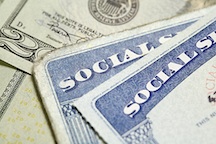Teamsters Local 992 Retirees meet on the second Wednesday of each month. Doors open at 5 p.m., and the meetings begin at 6 p.m.
They had been at the Wilson Ruritan Club, 16204 National Pike, Hagerstown, MD, but there will be a location change announced soon.
Meetings are suspended for the summer months of June, July and August.
A picnic is held on the second Saturday of June. All retirees will receive notice in advance.
The Retirees' Christmas Party is held on the second Wednesday of December.
President: Harrison "Tiny" Lushbaugh
Vice President: George L. Knight, Sr.
Treasurer: Mary Ann Hurd
Secretary: Mary Ann Hurd (temp)
Trustees: Don Baker, Raymond Smith, Melvin Rouzer
| Social Security and It’s Purported Death Spiral – and A Scam Warning |
|
|
By MICHELLE SINGLETARY
The Washington Post
July 24, 2017 | Whenever I talk about retirement, inevitably I’ll get a question about Social Security.
The questions always come down to this: “Will Social Security be around when I’m ready to retire?”
It’s a fair question because “nonretired Americans have become somewhat more likely to say Social Security will be “a major source” of income in their retirement, according to a Gallup poll.
Gallup said this belief is strongest among younger (age 18 to 29) and older (age 50 to 64) folks.
So what do the numbers look like for Social Security?
Washington Post columnist Allan Sloan crunched some numbers: Let’s run the fantasy math on Social Security
“Although Social Security’s programs are self-sufficient on paper, in reality they’re running into major problems,” he writes. “I’m not saying that Social Security is about to go under, which it isn’t; or that its programs are a fraud or Ponzi scheme, which they aren’t.”
Sloan writes that we should be concerned.
“Preserving Social Security in anything like its current form for our kids and grandkids involves sacrifice, not financial subterfuge,” he says. “We have to put in more cash and slow the growth in benefit outlays. Trusting in trust funds and ignoring reality won’t end well. You can trust me on that.”
Social Security scam
?If what Sloan has to say isn’t scary enough, there’s a new scam out there you need to avoid, according to the Social Security Administration.
The agency said in a warning last week that seniors have been reporting that people are calling pretending to be an administration employee.
The callers claim victims are entitled to a 1.7 percent cost-of-living adjustment increase of their Social Security benefits. But it’s all a lie. What these criminals really want is your financial information.
The impersonators “ask the victim to verify all of their personal information including their name, date of birth, Social Security number, parents’ names, etc. to receive the increase. If the impersonator is successful in acquiring this information, they use it to contact SSA and request changes to the victim’s direct deposit, address and telephone information,” according to the Social Security warning.
People may be falling for this scam because the agency sometimes will contact folks by telephone. So to be safe, no matter who calls, don’t confirm or give out any of your personal information if you did not initiate the contact. Instead call your local Social Security office or Social Security’s toll-free customer service number at 800-772-1213.
If you’ve been victimized by this scam call 800-269-0271 or submit a fraud report to the Social Security’s Office of the Inspector General.
Retirement rants and raves?
I’m interested in your experiences or concerns about retirement. Did you retire early and if so, how did you do it?
Is retirement everything you hoped for?
Are you scared you’ll run out of money?
What you share might help others. So send your comments to colorofmoney@washpost.com. Please include your name, city and state. In the subject line put “Retirement Rants and Raves.”
Thought I’d share the retirement rave of the week. It comes from Clyde K.
“My wife and I retired in June 2015, and we have wondered why we waited so long,” he wrote. “Actually, there was a very good reason, my wife could not retire until then and I did not want all the extra time on my hands without her.”
Okay, can I jump in here? How sweet was that?
Anyway, Clyde went on to write, “We are enjoying our retirement so much. So far it has been awesome. I am 73 and my wife is 64. We have traveled a lot. We have bought a small motor home and have made a nine-week trip and a four-week trip plus some shorter ones. We have another four-week trip planned to begin in October to Minnesota, Wisconsin and Michigan. We have taken three cruises since we retired and have another one scheduled in January 2018 for a full Panama Canal transit. Most of our money is in Exchange Traded Funds. All proceeds are reinvested. We are in the moderate risk range with about 60 percent in stock type ETFs. We are taking out more than my required minimum distribution (RMD) to boost our retirement income to pay for travel. We have delayed taking my wife’s Social Security until she turns 70. We plan to have her draw on my Social Security when she turns 66 and then switch to her account at age 70, which we think will produce a higher income stream. That is our basic structure and how we feel about being retired. RETIREMENT HAS BEEN GREAT SO FAR.”
Clyde mentioned two things — RMD and ETFs — that you might want to know more about. Here’s some information on both:
IRS Retirement Topics — Required Minimum Distributions (RMDs)
What’s better: ETFs or mutual funds?
Retirement bloggers
I believe that wealth happens intentionally and that means for me reading as much as I can about all things financial, especially retirement.
In this section of the newsletter, I’ll feature postings from various retirement blogs.
A reader, Rita, had a Social Security question that she thought would help her and other seniors.
She wrote: There was a procedure known as “file and suspend” but I don’t know how to do this. I am trying to find something definitive, in writing, that I can show to Social Security to collect benefits.
To answer her question I found a very informative blog posting by former Washington Post retirement columnist Stan Hinden.
Hinden wrote a blog post about this issue for AARP. The headline answers the larger question: Life After ‘File and Suspend’
As Hinden reports, “file and suspend” is history.
“The changes to Social Security were part of the Bipartisan Budget Act of 2015, which averted the threat of a government shutdown. To save money for Social Security, Congress eliminated a longtime claiming strategy.”
There was a small window to take advantage of the strategy, but it closed.
Hinden writes: “Acceptance of new applications for file and suspend officially ended on April 30, [2016] six months after the enactment of the legislation (though qualifying people who had filed before that were grandfathered in).”
If you want to know about a related known as “Restricted Application” click here.
Newsletter comments policy?
Please note it is my personal policy to identify readers who respond to questions I ask in my newsletters. I find it encourages thoughtful and civil conversation. I want my newsletters to be a safe place to express your opinion. On sensitive matters or upon request, I’m happy to include just your first name and/or last initial. But I prefer not to post anonymous comments (I do make exceptions when I’m asking questions that might reveal sensitive information or cause conflict.)
Have a question about your finances? Michelle Singletary has a weekly live chat every Thursday at noon where she discusses financial dilemmas with readers. You can also write to Michelle directly by sending an email to michelle.singletary@washpost.com. Personal responses may not be possible, and comments or questions may be used in a future column, with the writer’s name, unless otherwise requested. To read more Color of Money columns, go here.
Follow Michelle Singletary on Twitter (@SingletaryM) and Facebook www.facebook.com/MichelleSingletary
|
| Alliance for Retired Americans launch campaign to protect Medicare from privatization |
|
|
Speaker Paul Ryan and Rep. Tom Price, whom President-elect Trump will nominate to be Secretary of Health and Human Services, both said that they were moving to “reform” Medicare in the next Congress. Alliance members will be directly lobbying members of Congress and Senators in Washington and in their home districts, The Alliance will also campaign online and feature dozens of personal stories about why Medicare’s guaranteed benefits are so important on its website, https://retiredamericans.org, and social media.
“Our members are irate. they paid into the Medicare system for decade, and heard President-elect Trump repeatedly promise to protect their earned health care benefits. We will fight tooth and nail to protect Medicare from those who try to turn the earned benefits of Medicare into Coupon-care,” said Richard Fiesta, executive director of the Alliance.
|
| Those Pension Cuts and What You Need to Know |
|
|
Dec. 16, 2014 | AARP | Congress recently carved a hole in a 40-year-old pension law that has prevented employers from cutting benefits earned by those already retired. This change applies to people covered under multiemployer plans that are in critical financial shape.
Here’s what you need to know:
What is a multiemployer plan? This is a pension covering workers and retirees from more than one employer in the same or related industry, such as trucking or construction. (Most of them were established under collective bargaining between a union and the employers.) There are about 1,400 multiemployer plans with 10.4 million participants. Most workers with traditional pensions are in a single-employer plan, meaning it covers workers from only one employer.
 Why are lawmakers doing this? The federal Pension Benefit Guaranty Corp., which insures these pensions, says that some 10 percent of multiemployer plans – covering about 1.5 million people – are in such financial trouble that they are likely to become insolvent. PBGC estimated that its fund insuring multiemployer plans will likely run out of money in eight to 10 years unless changes are made. Some lawmakers argued that these distressed plans need the ability to cut retirees’ benefits so pensions can survive longer. Why are lawmakers doing this? The federal Pension Benefit Guaranty Corp., which insures these pensions, says that some 10 percent of multiemployer plans – covering about 1.5 million people – are in such financial trouble that they are likely to become insolvent. PBGC estimated that its fund insuring multiemployer plans will likely run out of money in eight to 10 years unless changes are made. Some lawmakers argued that these distressed plans need the ability to cut retirees’ benefits so pensions can survive longer.
AARP and other consumer advocates argue that these pensions aren’t in immediate danger of insolvency so there is no need to rush this drastic measure without considering alternatives, such as scaling back on optional benefits in a plan or providing PBGC with greater funds and the authority to intervene earlier. Advocates also worry this move by lawmakers might someday open the door to similar pension cuts to other plans.
How do I know if my pension is in financial trouble? Under a 2006 pension law, plans are required to notify participants if they are significantly underfunded. The U.S. Department of Labor also posts a list online of plans whose status is considered “critical” or “endangered.”
Will everyone in a distressed plan experience cuts? It’s up to plan trustees to decide how much to cut benefits, though the legislation offers certain restrictions. For instance, benefits cannot be cut for retirees age 80 and older or those receiving a disability pension. And those under age 75 would see bigger cuts than retirees at ages 75 to 79, whose benefits could be slashed but not as much.
How big are the cuts? Some retirees could see their benefits cut by more than 60 percent. The Pension Rights Center, an advocacy group, provides an online calculator to figure any potential benefit loss under the legislation for those under age 75.
Do retirees or workers get any say in these cuts? Participants will get to vote on any proposed pension cuts. Yet as the Pension Rights Center points out, this right is “illusory.” A majority of all participants – all employees and retirees, not just those voting – must reject the cuts, the group says. And ballots can be sent via email, a hurdle for those without Internet access. Yet even if participants overwhelmingly reject cuts, their vote can be simply set aside if the troubled plan may jeopardize the financial health of the PBGC, the group says.
When will this take effect? The pension provisions take effect beginning in 2015.
|
| How To Save Social Insurance (aka Entitlements) |
|
|
Via Blog of the Century
November 13, 2013
As part of the deal to end the government shutdown, the House and Senate are now working together to come up with a joint budget — Medicare and Social Security are sure to be part of that discussion. Many progressives argue that benefits paid for by Americans throughout their whole working lives should not change, either by modifying cost-of-living increases, cutting benefits or raising the retirement age (which wouldn’t actually do much good for the budget).
However, there may be a way to ensure these programs have the funds to continue paying future beneficiaries without taking anything away from current retirees.
 Capping Out Capping Out
Anyone who earns a paycheck knows the Federal Insurance Contributions Act, or FICA tax, is deducted to pay for Social Security and Medicare. In 2013, 7.65 percent of your paycheck will go to those two programs (6.2 percent to Social Security, and the rest to Medicare). Businesses must also pay the same amount for each employee.
But these payroll taxes apply only to earnings of up to $113,700 a year, which is this year’s cap (it rises from year to year). Any earnings above that are not subject to FICA taxes. If you earn $227,400 in 2013, for example, you would only pay FICA taxes on half of that.
The median income in the United States in 2012 was just over $51,000, according to the Census Bureau. This means that more than half of Americans already pay FICA taxes on all of their income.
Raising or eliminating the payroll tax cap would not alter most paychecks at all—as few as 5 percent of Americans would pay more. Since most employees would see no change, employers would not have to pay much more either.
Raise It To Save It
According to the program’s trustees, Social Security’s trust funds will be exhausted in 2033, and Medicare’s in 2026. Some action is needed to prevent this from occurring—the question is what.
The idea of eliminating the cap isn’t new. The Congressional Research Service estimated subjecting all earnings to payroll taxes would keep Social Security solvent for another seventy-five years.
Still, it’s a difficult sell. After all, any tax increase is politically difficult. Luckily, the plan can be retooled to appeal to policymakers and even benefit most Americans.
Here’s how:
Eliminate The Cap . . .
For starters, the payroll tax cap should be repealed, making all income subject to FICA taxes. The downside, apart from some wealthier Americans having to pay more, would be that some businesses with higher-paid employees could also see their burdens rise, since employer contributions match those of employees.
That’s where the second part of the plan comes in.
. . . Then Cut The Rate
Before this year, the United States implemented a payroll tax “holiday,” cutting the Social Security rate for employees to 4.2 percent from its usual 6.2 percent. (Businesses did not see a rate cut.) The Tax Policy Center found that households earned, on average, an extra $900 to $1,000 a year because of that cut. Unfortunately, it expired this year, curbing consumer spending.
To win support for eliminating the cap, policymakers could include a second, temporary payroll tax cut. To sweeten the deal, businesses could also receive a temporary rate cut, allowing those with highly paid employees to keep their payments lower for a few years.
Greater Good
It’s worth noting that cutting the Social Security rate to 4.2 percent would not only benefit the 95 percent of Americans who already pay FICA taxes on all of their income, but also many Americans who would have to pay taxes on more income.
For example, someone earning $150,000 a year will now pay $8,698.05 in FICA taxes on their first $113,700 of income. Paying 5.65 percent on all $150,000 would cut that bill to $8,475. If businesses saw a rate cut as well, expenses would decrease, allowing business owners to invest or bring on more workers.
Additionally, a proposed rate cut would have to be phased out eventually, otherwise benefits of this plan would be much smaller than anticipated. However, there is a simple fix: a half-percent increase each year for four years allows Americans to adapt.
The vast majority of Americans would still see a net tax cut over those four years and be no worse off afterward. Businesses without higher-paid workers would be unaffected, and could receive a temporary cut. Consumer spending would rise, boosting the economy.
Best of all, Social Security and Medicare would have the revenue needed for future beneficiaries.
http://www.tcf.org/blog/detail/how-to-save-entitlements-without-really-trying
|
| Chained CPI: Bargaining With Your Future |
|
|
The Chained-CPI isn't just a one-time cut. Each year that passes means more cuts for seniors.
.jpg) According to Social Security Works, an average earner who retired in 2011 at age 65 can expect to lose over $6,000 over 15 years if the Chained-CPI were adopted. According to Social Security Works, an average earner who retired in 2011 at age 65 can expect to lose over $6,000 over 15 years if the Chained-CPI were adopted.
The Chained-CPI formula fails to take into account the large health care costs and rising living expenses faced by seniors with limited income. Our seniors cannot just substitute triple bypass surgery with a double bypass because it's cheaper.
By considering a switch to Chained-CPI, Members of Congress are bargaining with our future. Use the Social Security benefits change calculator from AARP here to see how much you stand to lose, then share it with your friends and contact your legislator.
Source: www.seiu.org
|
| Social Security Benefit Increase Jan. 2012 |
|
|
Social Security to hand out first raises since '09
Via Associated Press
October 19, 2011 | Social Security recipients will get a raise in January -- their first increase in benefits since 2009. It's expected to be about 3.5 percent.
Some 55 million beneficiaries will find out for sure Wednesday when a government inflation measure that determines the annual cost-of-living adjustment is released.
 Congress adopted the measure in the 1970s, and since then it has resulted in annual benefit increases averaging 4.2 percent. But there was no COLA in 2010 or 2011 because inflation was too low. That was small comfort to the millions of retirees and disabled people who have seen retirement accounts dwindle and home values drop during the period of economic weakness, said David Certner, legislative policy director for the AARP. Congress adopted the measure in the 1970s, and since then it has resulted in annual benefit increases averaging 4.2 percent. But there was no COLA in 2010 or 2011 because inflation was too low. That was small comfort to the millions of retirees and disabled people who have seen retirement accounts dwindle and home values drop during the period of economic weakness, said David Certner, legislative policy director for the AARP.
"People certainly feel like they are falling behind, and these are modest income folks to begin with, so every dollar counts," Certner said. "I think sometimes people forget what seniors' incomes are."
Some of the increase in January will be lost to higher Medicare premiums, which are deducted from Social Security payments. Medicare Part B premiums for 2012 are expected to be announced next week, and the trustees who oversee the program are projecting an increase.
Monthly Social Security payments average $1,082, or about $13,000 a year. A 3.5 percent increase would amount to an additional $38 a month, or about $455 a year.
Most retirees rely on Social Security for a majority of their income, according to the Social Security Administration. Many rely on it for more than 90 percent of their income.
Mark Zandi, chief economist at Moody's Analytics, said the COLA would give a boost to consumer spending next year, amounting to about $25 billion in government support, or 0.2 percent more economic growth, if beneficiaries spend it all. For comparison, last year's 2 percentage point cut in Social Security payroll taxes was worth $115 billion to U.S. households.
"It is not a magic bullet for the economy, but it will certainly be a positive for households on fixed incomes," he said.
Federal law requires the program to base annual payment increases on the Consumer Price Index for Urban Wage Earners and Clerical Workers (CPI-W). Officials compare inflation in the third quarter of each year -- the months of July, August and September -- with the same months in the previous year.
If consumer prices increases from year to year, Social Security recipients automatically get higher payments, starting the next January. If price changes are negative, the payments stay unchanged.
Only twice since 1975 -- the past two years -- has there been no COLA.
Wednesday's COLA announcement will come as a special joint committee of Congress weighs options to reduce the federal government's $1.3 trillion budget deficit. In talks this summer, President Barack Obama floated the idea of adopting a new measure of inflation to calculate the COLA, one that would reduce the annual increases.
Advocates for seniors mounted an aggressive campaign against the proposal, and it was scrapped. But it could resurface in the ongoing talks.
"We're very concerned about that," said Web Phillips of the National Committee to Preserve Social Security and Medicare. "I think that what this illustrates is the dangers of trying to make Social Security policy in the context of deficit reduction."
Social Security payments increased by 5.8 percent in 2009, the largest increase in 27 years, after energy prices spiked in 2008. But energy prices quickly dropped and home prices became soft in markets across the country, contributing to lower inflation the past two years.
For example, average gasoline prices topped $4 a gallon in the summer of 2008. But by January 2009, they had fallen below $2. Today, the national average is about $3.46 a gallon.
"A lot of that increase had to do with energy," Polina Vlasenko, an economist at the American Institute for Economic Research, based in Great Barrington, Mass., said of the 2009 change.
As a result, Social Security recipients got an increase that was far larger than actual overall inflation. However, they weren't to get another increase until consumer prices exceeded the levels measured in 2008.
So far this year, prices have been higher than that, Vlasenko said. Based on consumer prices in July and August, the COLA for 2012 would be about 3.5 percent. Vlasenko estimates the COLA will be from 3.5 percent to 3.7 percent.
Advocates for seniors say it's about time.
"If you've been at the grocery store lately and remember what you used to pay for things, see what you're paying for things today," Phillips said. "The cost-of-living adjustment makes sure that the Social Security benefit that you qualify for when you retire or you become disabled continues to stay current with prices so that the buying power of your benefit does not decline over time."
|
| Consumers Don't Drive Health Care Costs |
|
It’s the Prices, Stupid.
By Richard Kirsch /New Deal 2.0
MAy 13, 2011
Republican plans that shift costs to consumers completely misunderstand the United States’ health care system.
Yesterday, Speaker Boehner issued what Robert Bob Borosage of Campaign for America’s Future correctly labeled extortion: “Give us trillions in cuts in Medicare and Medicaid or we blow up the economy.” Boehner’s threat to tie the lifting of the debt ceiling to trillions of cuts in spending would force huge cuts in Medicare and Medicaid.
Actually, there are no health care cost savings in the Ryan-Boehner budget, just cost shifts. The Ryan budget cuts Medicare by shifting more than $6,000 a year to each senior who benefits from it. It shifts Medicaid costs to state taxpayers by cutting federal funding to states for the program.
 While the extremes of the Ryan-Boehner budget have been widely decried, the underlying assumption behind their Medicare privatization plan is too often accepted by a broad array of health policy advisers. The Ryan budget assumes that the problem with health costs is that consumers don’t pay enough out of pocket for care and that plans are too generous. Unfortunately, that’s also been the view of some Democratic health policy advisers. White House officials backed the taxation of higher cost health plans in the Affordable Care Act (ACA), and others like former Clinton OMB Director Alice Rivlin support a less draconian version of Medicare privatization. While the extremes of the Ryan-Boehner budget have been widely decried, the underlying assumption behind their Medicare privatization plan is too often accepted by a broad array of health policy advisers. The Ryan budget assumes that the problem with health costs is that consumers don’t pay enough out of pocket for care and that plans are too generous. Unfortunately, that’s also been the view of some Democratic health policy advisers. White House officials backed the taxation of higher cost health plans in the Affordable Care Act (ACA), and others like former Clinton OMB Director Alice Rivlin support a less draconian version of Medicare privatization.
But the reason that health care costs so much in the United States is not that we consume too much health care; it’s that we pay too much for what we consume.* As Uwe Reinhardt and three other health economists summarized succinctly after comparing the prices we pay and the amount of health care we use in the United States with other developed countries, “It’s the prices, stupid.”
For example, we make one-third fewer doctor visits a year than people in other countries but we pay an average of $59 for an office visit, compared with $31 in France. Our doctors make a lot more money than their colleagues in other countries. Adjusting pay across countries by purchasing power, U.S. doctors get paid about two times as much as in others. A Congressional Research Service analysis found that specialists in the United States are paid about $50,000 a year more than would be predicted, even considering the higher level of wealth in the United States.
 We go to the hospital a lot less, too, and when we’re there we don’t stay as long. But we pay a lot more. The average hospital stay costs us $3,181, compared with $837 in Canada. We do get a lot more MRIs in the United States, more than twice as much as other countries, and we also pay a lot more for each scan: an average of $1,200 compared to $839 in Germany. And as everyone knows, the price of brand-name prescription drugs is much higher in the United States than other countries. We go to the hospital a lot less, too, and when we’re there we don’t stay as long. But we pay a lot more. The average hospital stay costs us $3,181, compared with $837 in Canada. We do get a lot more MRIs in the United States, more than twice as much as other countries, and we also pay a lot more for each scan: an average of $1,200 compared to $839 in Germany. And as everyone knows, the price of brand-name prescription drugs is much higher in the United States than other countries.
Why do we pay so much more for the same product? The biggest reason is that other countries understand that health care is a public good, not a commodity. Markets can’t control health care prices, since it is health care providers who decide what care is delivered. When providers determine both demand and supply, market economics don’t apply.
Even in the United States, with all the political pressure from the doctor, hospital, and drug lobbies, we can see how a public insurance entity does a better job of controlling prices than private insurance. Medicare sets prices and pays $500 for an MRI, less than half the $1,200 U.S. average. Even with its older patients, Medicare pays $2,200 for an average hospital stay, almost 50% less than the U.S. average.
Private insurance companies not only fail to control prices, they add costs. The private insurance companies that Ryan wants to hand Medicare over to are the primary reason that we spend more than four times as much on administrative and insurance costs in the United States as other countries.
Which brings us to another market-driven argument that underlies the Ryan proposal and other conservative nostrums for controlling health care costs: that because Americans have insurance they are not prudent purchasers of health coverage. Again, the international comparison should put this to rest, as in all those other countries with much lower health spending everyone is fully covered. In these countries, the only prudent  purchaser is the government, which is responsible for getting lower prices. As it is, the amount that Americans pay out-of-pocket for health care is already a lot more than consumers in other developed countries, even accounting for our higher incomes. purchaser is the government, which is responsible for getting lower prices. As it is, the amount that Americans pay out-of-pocket for health care is already a lot more than consumers in other developed countries, even accounting for our higher incomes.
The Obama budget plan begins to address the root causes of high health care costs by increasing the authority of a new public entity designed to control what Medicare pays for health care. The President contrasted his budget approach with that of the Republican budget in his April 13th budget address at George Washington University, saying: “Their plan essentially lowers the government’s health care bills by asking seniors and poor families to pay them instead. Our approach lowers the government’s health care bills by reducing the cost of health care itself.”
The centerpiece of Obama’s plan to control Medicare costs is to add additional powers to a new body established under the ACA called the Independent Payment Advisory Board (IPAB). The IBAP will function as a kind of military base closing commission for Medicare. If the growth in Medicare costs exceeds a target amount, then it would institute cost control measures that would go into effect unless Congress intervened. Since cutting eligibility and benefits are not part of the IPAB mandate, cost savings would have to come from the actual drivers of cost: the prices paid for services and the way health care services are delivered.
Obama’s budget proposal would strengthen the IPAB’s current authority, although the details of how to do that have not yet been specified. As you can imagine, it is already a target of attack from health care providers who are finding a sympathetic ear among both Republicans and Democrats in Congress. It’s also a favorite target of the right, which calls it “Obama’s death panel.”
The battle being fought over Medicare is, like every other economic issue that faces the nation, a matter of power and a test of our democracy. We can control health care costs and improve the quality of care by addressing the root causes: our market-driven health care system pays too much for care and rewards quantity over quality. But changing the way we finance and pay for health care will mean putting the interest of consumers over the power of the industry lobby. For the doctors, hospitals, drug companies, medical device manufacturers and insurance companies, a dollar saved is a dollar lost in revenue.
The firestorm of popular opposition to the Ryan Medicare plan is because he chose to side with industry over seniors. But with Boehner threatening to hold the economy hostage, and a health industry that has enormous lobbying clout, the future of our nation’s national health insurance system for seniors and the disabled remains in grave doubt.
Richard Kirsch is a Senior Fellow at the Roosevelt Institute, whose book on the campaign to win reform will be published in 2012. He was National Campaign Manager of Health Care for America Now during the legislative battle to pass reform.
*In 2000 the United States spent considerably more on health care than any other country, whether measured per capita or as a percentage of GDP. At the same time, most measures of aggregate utilization such as physician visits per capita and hospital days per capita were below the OECD median. Since spending is a product of both the goods and services used and their prices, this implies that much higher prices are paid in the United States than in other countries. But U.S. policymakers need to reflect on what Americans are getting for their greater health spending. They could conclude: It’s the prices, stupid. ~ HealthAffairs.org
|
| Is Your Rebate Check in The Mail? |
|
|
It is if you hit the Medicare prescription drug gap, commonly called the donut hole.
The tax-free, one-time $250 rebate check is part of the Health Care Reform Implementation, and the first step towards closing the donut hole – the period during which retirees must pay for all of their prescription drugs.
 However, Teamster retirees who get prescription drug coverage directly from a Teamster Health & Welfare fund may not qualify for this benefit. That's because the coverage you already have is better than most Medicare Part D coverage. However, Teamster retirees who get prescription drug coverage directly from a Teamster Health & Welfare fund may not qualify for this benefit. That's because the coverage you already have is better than most Medicare Part D coverage.
If you're not sure whether you qualify, please ask your plan administrator. If you do qualify, you don't need to provide any personal information (such as Medicare, Social Security, or bank account numbers) to get the rebate check. Don't give your personal information to anyone who calls you about the $250 rebate check. Call 1-800-MEDICARE (1-800-633-4227) to report anyone who calls you about it. TTY users should call 1-800-486-2048.
FAQs:
Why will some people be getting checks?
Because the new health are reform law created a program to help retirees with the high cost of prescription drugs. The "Medicare Part D Coverage Gap Discount Program" pays $250 toward prescription drugs when participants reach the coverage gap or "donut hole." The program is for retirees eligible for Medicare.
What is the coverage gap?
The coverage gap occurs when the total drug spending by the plan and the participant reaches $2,830, until the total out-of-pocket cost reaches $4,550. Many retired Teamsters actually have prescription drug coverage that is much better that Medicare Part D and do not have any coverage gap at all.
Who will get the check?
Retirees who participate in a Medicare Part D Prescription Drug Program (PDP) or a Medicare Advantage Program with Prescription Drugs (MA-PD). Retirees won't get a check if they've enrolled in prescription drug programs that don't have a coverage gap.
What can I expect if I'm eligible to receive a check?
You will receive a one-time, tax-free $250 rebate check in the mail. Beginning on January 1, 2011, you will receive a 50% discount on brand name drugs at the pharmacy once you reach the coverage gap.
How will I know if I've reached the coverage gap?
The Explanation of Benefits notice, which your drug plan mails to you each month when you fill a prescription, will tell you how much you've spent on covered drugs and whether you've entered the coverage gap. If your PDP or MA-PD pays some of your costs during the coverage gap, you ill still receive a discount after you've reached the gap starting in January 1, 2011. However, the discount you receive will depend on how much your plan supplements your coverage during the coverage gap. The discount will be only on what you actually pay, and not on the full price of the drug.
Will I need to do anything to get this rebate check?
No. There are no forms to fill out. Medicare will automatically send a check that's made out to you. You don;t need to provide any personal information – like your Medicare, Social Security, or bank account numbers to get the rebate check. Do NOT give your personal information to anyone who calls you about the $250 rebate check.
When will I get the rebate check?
If you reach the coverage gap this year, you will receive a $250 check if you are not already receiving Medicare Extra Help. These checks started being mailed in mid-June. Checks will be mailed monthly throughout the year as beneficiaries enter the coverage gap. However, this is a one-time benefit. If you qualify, you will only receive one check after you reach the coverage gap.
Will I have to pay taxes on this rebate check?
No. It is tax-free.
What if I don't get the check when I should?
If you hit the donut hole after the program has begun, yu should receive your check within 45 days. Your rebate may be delayed if Medicare doesn't have information from your Medicare drug plan showing that you reached the coverage gap in time for mailing. You should call your Medicare drug plan to make sure all of your information has been sent to Medicare.
If you don't get your rebate check, contact Medicare at 1-800-MEDICARE. Individuals receiving Medicare Extra Help will not receive a rebate check. You can also make sure Social Security has your correct home address. Call 1-800-772-1213, or your local Social Security office. TTY users should call 1-800-325-0778.
Have other questions about the $250 rebate check or the Affordable Care Act and Medicare?
You can visit www.medicare.gov, or call 1-800-MEDICARE.
– This information was provided to all locals by the IBT Communications Department.
Photo/Getty Images
|
Page Last Updated: Jul 24, 2017 (12:54:46)
|




 Why are lawmakers doing this? The federal Pension Benefit Guaranty Corp., which insures these pensions, says that some 10 percent of multiemployer plans – covering about 1.5 million people – are in such financial trouble that they are likely to become insolvent. PBGC estimated that its fund insuring multiemployer plans will likely run out of money in eight to 10 years unless changes are made. Some lawmakers argued that these distressed plans need the ability to cut retirees’ benefits so pensions can survive longer.
Why are lawmakers doing this? The federal Pension Benefit Guaranty Corp., which insures these pensions, says that some 10 percent of multiemployer plans – covering about 1.5 million people – are in such financial trouble that they are likely to become insolvent. PBGC estimated that its fund insuring multiemployer plans will likely run out of money in eight to 10 years unless changes are made. Some lawmakers argued that these distressed plans need the ability to cut retirees’ benefits so pensions can survive longer. Capping Out
Capping Out.jpg) According to Social Security Works, an average earner who retired in 2011 at age 65 can expect to lose over $6,000 over 15 years if the Chained-CPI were adopted.
According to Social Security Works, an average earner who retired in 2011 at age 65 can expect to lose over $6,000 over 15 years if the Chained-CPI were adopted.  Congress adopted the measure in the 1970s, and since then it has resulted in annual benefit increases averaging 4.2 percent. But there was no COLA in 2010 or 2011 because inflation was too low. That was small comfort to the millions of retirees and disabled people who have seen retirement accounts dwindle and home values drop during the period of economic weakness, said David Certner, legislative policy director for the AARP.
Congress adopted the measure in the 1970s, and since then it has resulted in annual benefit increases averaging 4.2 percent. But there was no COLA in 2010 or 2011 because inflation was too low. That was small comfort to the millions of retirees and disabled people who have seen retirement accounts dwindle and home values drop during the period of economic weakness, said David Certner, legislative policy director for the AARP. While the extremes of the Ryan-Boehner budget have been widely decried, the underlying assumption behind their Medicare privatization plan is too often accepted by a broad array of health policy advisers. The Ryan budget assumes that the problem with health costs is that consumers don’t pay enough out of pocket for care and that plans are too generous. Unfortunately, that’s also been the view of some Democratic health policy advisers. White House officials backed the taxation of higher cost health plans in the Affordable Care Act (ACA), and others like former Clinton OMB Director Alice Rivlin support a less draconian version of Medicare privatization.
While the extremes of the Ryan-Boehner budget have been widely decried, the underlying assumption behind their Medicare privatization plan is too often accepted by a broad array of health policy advisers. The Ryan budget assumes that the problem with health costs is that consumers don’t pay enough out of pocket for care and that plans are too generous. Unfortunately, that’s also been the view of some Democratic health policy advisers. White House officials backed the taxation of higher cost health plans in the Affordable Care Act (ACA), and others like former Clinton OMB Director Alice Rivlin support a less draconian version of Medicare privatization.  We go to the hospital a lot less, too, and when we’re there we don’t stay as long. But we pay a lot more. The average hospital stay
We go to the hospital a lot less, too, and when we’re there we don’t stay as long. But we pay a lot more. The average hospital stay  purchaser is the government, which is responsible for getting lower prices. As it is, the amount that Americans pay out-of-pocket for health care is already a lot more than consumers in other developed countries, even accounting for our higher incomes.
purchaser is the government, which is responsible for getting lower prices. As it is, the amount that Americans pay out-of-pocket for health care is already a lot more than consumers in other developed countries, even accounting for our higher incomes.  However, Teamster retirees who get prescription drug coverage directly from a Teamster Health & Welfare fund may not qualify for this benefit. That's because the coverage you already have is better than most Medicare Part D coverage.
However, Teamster retirees who get prescription drug coverage directly from a Teamster Health & Welfare fund may not qualify for this benefit. That's because the coverage you already have is better than most Medicare Part D coverage. 



